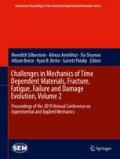Abstract
The method of thin-wall tube torsion to characterize metal’s shear response is well-known. Unfortunately, the thin wall tube specimen tends to buckle before reaching large shear deformation and failure. An alternative technique, which has rarely been considered, is Nadai’s surface stress method (Nadai, Theory of Flow and Fracture of Solids. McGraw-Hill, New York, 1950). It derives shear stress-strain curve from the torque-twist relationship of a solid bar. Although the analysis is more complex due to nonlinear shear stress distribution along the radius, the deformation is stable through large shear deformation to failure.
Solid bar torsion experiments were conducted to study large shear deformation of Al6061-T6. Two experiments were described in this study. Since few tests were available in the literature, these experiments were to explore the large deformation behaviors of an engineering alloy and the application of modern measurement techniques, such as 3D DIC method, under torsion. Results show during twisting, the surface shear strain distribution was uniform initially and then localized on a narrow band; eventually, the specimen was cracked and failed within the band. Depending on the specimen size, the twist could be greater than 360°. Details are discussed.
Access this chapter
Tax calculation will be finalised at checkout
Purchases are for personal use only
References
A. Nadai, Theory of Flow and Fracture of Solids, 3rd edn. (McGraw-Hill, New York, 1950)
H.C. Wu, Z. Xu, P.T. Wang, The shear stress-strain curve determination from torsion test in the large strain range. J. Test. Eval. 20, 396–402 (1992)
Acknowledgements
Sandia National Laboratories is a multimission laboratory managed and operated by National Technology and Engineering Solutions of Sandia, LLC., a wholly owned subsidiary of Honeywell International, Inc., for the U.S. Department of Energy’s National Nuclear Security Administration under contract DE-NA-0003525. The views expressed in the article do not necessarily represent the views of the U.S. Department of Energy or the United States Government.
Author information
Authors and Affiliations
Corresponding author
Editor information
Editors and Affiliations
Rights and permissions
Copyright information
© 2020 Society for Experimental Mechanics, Inc.
About this paper
Cite this paper
Lu, WY., Jin, H., Foulk, J., Ostien, J. (2020). Solid Cylindrical Bar Torsion for Characterizing Shear Plastic Deformation and Failure. In: Silberstein, M., Amirkhizi, A., Shuman, X., Beese, A., Berke, R., Pataky, G. (eds) Challenges in Mechanics of Time Dependent Materials, Fracture, Fatigue, Failure and Damage Evolution, Volume 2. Conference Proceedings of the Society for Experimental Mechanics Series. Springer, Cham. https://doi.org/10.1007/978-3-030-29986-6_9
Download citation
DOI: https://doi.org/10.1007/978-3-030-29986-6_9
Published:
Publisher Name: Springer, Cham
Print ISBN: 978-3-030-29985-9
Online ISBN: 978-3-030-29986-6
eBook Packages: EngineeringEngineering (R0)

